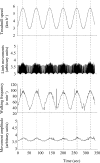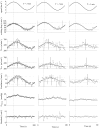The control of ventilation is dissociated from locomotion during walking in sheep
- PMID: 15235099
- PMCID: PMC1665074
- DOI: 10.1113/jphysiol.2003.057729
The control of ventilation is dissociated from locomotion during walking in sheep
Abstract
This study was designed to test the hypothesis that the frequency response of the systems controlling the motor activity of breathing and walking in quadrupeds is compatible with the idea that supra-spinal locomotor centres could proportionally drive locomotion and ventilation. The locomotor and the breath-by-breath ventilatory and gas exchange (CO2 output (VCO2) and O2 uptake (VO2)) responses were studied in five sheep spontaneously walking on a treadmill. The speed of the treadmill was changed in a sinusoidal pattern of various periods (from 10 to 1 minute) and in a step-like manner. The frequency and amplitude of the limb movements, oscillating at the same period as the treadmill speed changes, had a constant gain with no phase lag (determined by Fourier analysis) regardless the periods of oscillations. In marked contrast, when the periods of speed oscillations decreased, the amplitude (peak-to-mean) of minute ventilation (VE) oscillations decreased sharply and significantly (from 6.1 +/- 0.4 l min(-1) to 1.9 +/- 0.2 l min(-1)) and the phase lag between ventilation and treadmill speed oscillations increased (to 105 +/- 25 degrees during the 1 min oscillation periods). VE response followed VCO2 very closely. The drop in VE amplitude ratio was proportional to that in VCO2 (from 149 +/- 48 ml min(-1) to 38 +/- 5 ml min(-1)) with a slightly longer phase lag for ventilation than for VCO2. These results show that beyond the onset period of a locomotor activity, the amplitude and phase lag of the VE response depends on the period of the walking speed oscillations, tracking the gas exchange rate, regardless of the amplitude of the motor act of walking. Locomotion thus appears unlikely to cause a simple parallel and proportional increase in ventilation in walking sheep.
Figures








Similar articles
-
Dynamic Characteristics of Ventilatory and Gas Exchange during Sinusoidal Walking in Humans.PLoS One. 2017 Jan 11;12(1):e0168517. doi: 10.1371/journal.pone.0168517. eCollection 2017. PLoS One. 2017. PMID: 28076413 Free PMC article. Clinical Trial.
-
Metabolic cost of locomotion during treadmill walking with blood flow restriction.Clin Physiol Funct Imaging. 2014 Jul;34(4):308-16. doi: 10.1111/cpf.12098. Epub 2013 Nov 18. Clin Physiol Funct Imaging. 2014. PMID: 24237757
-
Stimulation of ventilation by normobaric hyperoxia in exercising dogs.Exp Physiol. 2000 Nov;85(6):829-38. Exp Physiol. 2000. PMID: 11187977
-
Kinematic control of walking.Arch Ital Biol. 2002 Oct;140(4):263-72. Arch Ital Biol. 2002. PMID: 12228979 Review.
-
Organizing network action for locomotion: insights from studying insect walking.Brain Res Rev. 2008 Jan;57(1):162-71. doi: 10.1016/j.brainresrev.2007.06.028. Epub 2007 Aug 21. Brain Res Rev. 2008. PMID: 17888515 Review.
Cited by
-
Alterations in step frequency and muscle activities using body weight support influence the ventilatory response to sinusoidal walking in humans.Sci Rep. 2023 Sep 19;13(1):15534. doi: 10.1038/s41598-023-42811-w. Sci Rep. 2023. PMID: 37726511 Free PMC article.
-
Control of arterial PCO2 by somatic afferents in sheep.J Physiol. 2005 Dec 15;569(Pt 3):975-87. doi: 10.1113/jphysiol.2005.089649. Epub 2005 Oct 13. J Physiol. 2005. PMID: 16223767 Free PMC article.
-
Inaugural Review Prize 2023: The exercise hyperpnoea dilemma: A 21st-century perspective.Exp Physiol. 2024 Aug;109(8):1217-1237. doi: 10.1113/EP091506. Epub 2024 Mar 29. Exp Physiol. 2024. PMID: 38551996 Free PMC article. Review.
-
Dynamic Characteristics of Ventilatory and Gas Exchange during Sinusoidal Walking in Humans.PLoS One. 2017 Jan 11;12(1):e0168517. doi: 10.1371/journal.pone.0168517. eCollection 2017. PLoS One. 2017. PMID: 28076413 Free PMC article. Clinical Trial.
-
Influence of Age on Cardiorespiratory Kinetics During Sinusoidal Walking in Humans.Front Physiol. 2018 Aug 24;9:1191. doi: 10.3389/fphys.2018.01191. eCollection 2018. Front Physiol. 2018. PMID: 30197604 Free PMC article.
References
-
- Bakker HK, Struikenkamp RS, De Vries GA. Dynamics of ventilation, heart rate, and gas exchange: sinusoidal and impulse work loads in man. J Appl Physiol. 1980;48:289–301. - PubMed
-
- Bisgard GE, Forster HV, Mesina J, Sarazin RG. Role of the carotid body in hyperpnea of moderate exercise in goats. J Appl Physiol. 1982;52:1216–1222. - PubMed
-
- Casaburi R, Whipp BJ, Wasserman K, Beaver WL, Koyal SN. Ventilatory and gas exchange dynamics in response to sinusoidal work. J Appl Physiol. 1977;42:300–301. - PubMed
-
- Casaburi R, Whipp BJ, Wasserman K, Koyal SN. Ventilatory and gas exchange responses to cycling with sinusoidally varying pedal rate. J Appl Physiol. 1978;44:97–103. - PubMed
Publication types
MeSH terms
LinkOut - more resources
Full Text Sources
Miscellaneous

